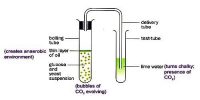Aerobic processes in cellular respiration can only occur if oxygen is present, Anaerobic processes do not use oxygen. Main Differences between Aerobic and Anaerobic Respiration:
- Oxygen: Require Oxygen
- Pyruvic Acid: Pyruvic Acid oxidized completely.
- Production of ATP: From one molecule glucose there produces 38 ATP
- End products: From each molecule of glucose there produce 6 molecules of CO2 and 6 molecules of water.
Example: Glucose + Oxygen → Carbon dioxide + Water + Energy
Chemical Equation: C6 H12 O6 + 6O2 → 6CO2 + 6H2 O + 2900 kJ/mol
- Oxygen: Do not require Oxygen
- Pyruvic Acid: Pyruvic Acid oxidized incompletely
- Production of ATP: From each molecule of glucose there produces 2 ATP
- End products: From each molecule of glucose there produce 2 molecules of ethanol and 2 molecules of CO2 or only 2 molecules of Lactic acid. No water is produced there.
Example: Glucose → Lactic acid + Energy
Chemical Equation: C6 H12 O6 → 2C3 H6 O3 + 120 kJ/mol













